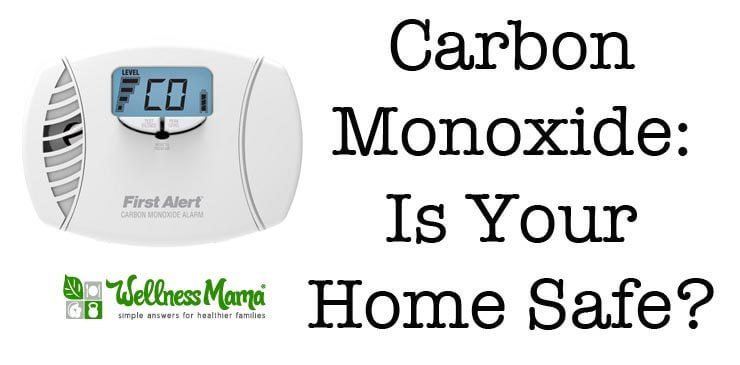This post is on a pretty basic topic that isn’t necessarily specific to natural living, but is vitally important for health, especially this time of year. Preventing carbon monoxide poisoning takes less time than oil pulling, costs less than fermented cod liver oil, and is an important safety topic for your family to prepare for.
Carbon Monoxide
Carbon monoxide poisoning kills hundreds each year and sends 20,000 more to the emergency room, especially during the winter months. In fact, I’m choosing to write about this now because the daughter of someone living near us was recently hospitalized after being found unconscious in her crib from carbon monoxide poisoning.
Carbon monoxide is an odorless and colorless gas, making it undetectable by human senses.
The most common symptoms of CO poisoning are headache, dizziness, weakness, nausea, vomiting, chest pain, and confusion. High levels of CO inhalation can cause loss of consciousness and death. Unless suspected, CO poisoning can be difficult to diagnose because the symptoms mimic other illnesses. People who are sleeping or intoxicated can die from CO poisoning before ever experiencing symptoms.
This is especially dangerous because red blood cells can uptake carbon monoxide faster than oxygen so if there is a lot of carbon monoxide in the air, it can replace oxygen in cells, leading to injury, tissue damage and eventually death.
Children, unborn babies, the elderly and those with health conditions are especially at risk. Since the symptoms of carbon monoxide poisoning resemble the symptoms of other illnesses, many people don’t realize they have carbon monoxide poisoning until some damage has been done.
What Causes High Carbon Monoxide Levels?
Carbon monoxide is produced by liquid or solid fuel sources like a gas burning appliances or a wood burning stove. Things like gas heat or a gas water heater can also be a source of carbon monoxide. Vehicles running in an enclosed area like a garage can also cause carbon monoxide poisoning. These are considered potential sources of carbon monoxide:
- Wood burning stoves, heaters or fireplaces
- Any type of oil heating appliance like a furnace, fireplace, or boiler
- Any oil, propane or natural gas appliance like a water heater, furnace, heater, cooking stove, range or fireplace
The Consumer Product Safety Commission provides these suggestions for avoiding carbon monoxide poisoning:
- Make sure appliances are installed and operated according to the manufacturer’s instructions and local building codes. Most appliances should be installed by qualified professionals. Have the heating system professionally inspected and serviced annually to ensure proper operation. The inspector should also check chimneys and flues for blockages, corrosion, partial and complete disconnections, and loose connections.
- Never service fuel-burning appliances without proper knowledge, skill and tools. Always refer to the owners manual when performing minor adjustments or servicing fuel-burning equipment.
- Never operate a portable generator or any other gasoline engine-powered tool either in or near an enclosed space such as a garage, house, or other building. Even with open doors and windows, these spaces can trap CO and allow it to quickly build to lethal levels.
- Install a CO alarm that meets the requirements of the current UL 2034 safety standard. A CO alarm can provide some added protection, but it is no substitute for proper use and upkeep of appliances that can produce CO. Install a CO alarm in the hallway near every separate sleeping area of the home. Make sure the alarm cannot be covered up by furniture or draperies.
- Never use portable fuel-burning camping equipment inside a home, garage, vehicle or tent unless it is specifically designed for use in an enclosed space and provides instructions for safe use in an enclosed area.
- Never burn charcoal inside a home, garage, vehicle, or tent.
- Never leave a car running in an attached garage, even with the garage door open.
- Never use gas appliances such as ranges, ovens, or clothes dryers to heat your home.
- Never operate unvented fuel-burning appliances in any room where people are sleeping.
- Do not cover the bottom of natural gas or propane ovens with aluminum foil. Doing so blocks the combustion air flow through the appliance and can produce CO.
- During home renovations, ensure that appliance vents and chimneys are not blocked by tarps or debris. Make sure appliances are in proper working order when renovations are complete.
How to Detect Carbon Monoxide
Most states and many countries require carbon monoxide detectors but only in homes that have an active source of carbon monoxide like a gas burning stove or fireplace, or a wood burning stove.
We have always had a carbon monoxide detector, even when we lived in a house that didn’t have any carbon monoxide producing appliances. Here’s why…
A study in the Journal of the American Medical Association found that carbon monoxide can pass through drywall. (source) Our family lived in apartments for many years before we bought a home, and especially in apartments and duplexes, carbon monoxide can seep through the walls from a neighboring unit, making it possible to get carbon monoxide poisoning even if you don’t have a carbon monoxide producing device.
An inexpensive carbon monoxide detector can detect dangerous levels of carbon monoxide and provide peace of mind. If you have a carbon monoxide detector that goes off or you suspect that you have carbon monoxide poisoning, immediately get outside or to a source of fresh air and call the appropriate emergency department.
Do You Need a Detector?
Since we’ve always had small children, I’ve always considered having a carbon monoxide detector a simple step we could take to avoid even the chance of carbon monoxide poisoning in our children.
At our home, we have these plug in carbon monoxide detectors with a battery backup. They were top rated by Consumer Reports and on Amazon. We have on on each floor of our house, close to things that have potential to create carbon monoxide (gas water heater, heater and fireplace).
There are also completely battery operated carbon monoxide detectors and completely plug in detectors that are slightly cheaper.
Especially if you have a carbon monoxide producing device, please get a carbon monoxide detector with a good rating to make sure your family and your home is safe.
Do you have a carbon monoxide detector?




Leave a Reply